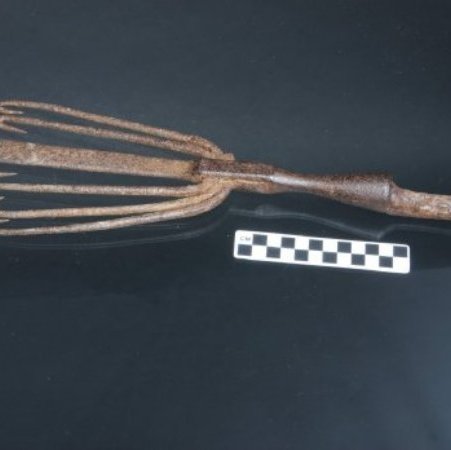Object Name:
Six Prong Eel Spear
Date:
1900s
Description of Object:
This spear has a flat, metal head with a central unbarbed prong and six barbed prongs on either side. At some point the furthest most right barbed prong became separated from the metal head. This head is not attached to a tapered pole as eels spears typically were.
About the Object:
This is a spear for catching the American Eel (Anguilla rostrata). It is most likely cast iron, and measures 15.9 inches (403 mm) from mounting socket to the tip of the center blade. Handles range from 10-20 feet in length. When thrust into mud, the tynes capture the eel because of its natural inclination to twist back and forth. Eels prefer muddy bottoms and calm waters. They are nocturnal, and during the day hide under rocks or in mud. Spears are used particularly in the colder months when eels burrow into the mud and reamain inactive.
More Information:
The American Eel stock is considered depleted by the ASMFC. In Maryland, glass eel and elver fisheries are prohibited. The size minimum is 9 inches. A commercial fishery seasonal closure was introduced in 2014, and small eel pot mesh sizes are being eliminated. Commercial crabbers may harvest eel for trotline bait and the daily recreational creel is 25 eels. The record high catch of 918,000 lbs. was recorded in 2010. This fell to 568,000 lbs. in 2013. Stock depletion is likely due to a combination of fishing pressure, habitat loss from damming and development, hydroelectric turbines, pollution, parasites, and disease.



